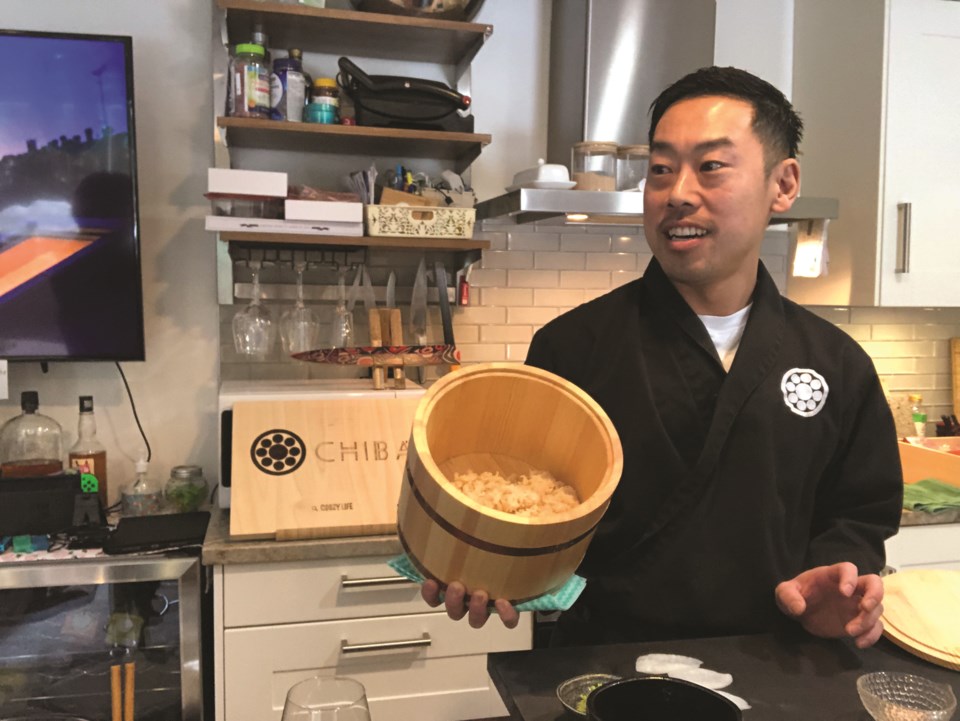Over the course of his career, Japanese chef Koji Chiba has had the chance to serve a list of distinguished dinner guests that would intimidate even the most seasoned cooks.
“I used to work at a five-star hotel in Tokyo and I served the Emperor of Japan, the King of Sweden, the G8 summit, and lots of VIP people in the world,” said Chiba.
Now, Whistlerites can enjoy the VIP treatment themselves thanks to Chiba’s new venture: high-end, omakase-style private tastings for the discerning sushi lover.
After seven years at Nagomi Sushi in the Upper Village, Chiba decided it was time to set off on his own. “It was time to leave to do it myself as a business. That was one of my dreams when I was kid, and also to be a sushi chef, too,” Chiba explained.
Visiting the sushi restaurants dotting the West Coast, Chiba couldn’t help but notice there weren’t many places doing sushi the traditional Japanese way. He saw an opportunity.
“I thought, ‘I should do the traditional style in North America, plus mix in the essence from the North American culture, like sushi rolls. Then I can add my essence as well,” he said. “It’s gonna be the perfect match, especially in Whistler.”
The result is an exquisite, multi-course culinary experience that blends Chiba’s penchant for traditional techniques and ingredients with the quality seafood that can be found in B.C.’s waters. An accomplished fishermen in his own right, Chiba will sometimes catch his own fish, like the white king salmon he caught from Campbell River that wound up on our plate for a recent tasting at Chiba’s home. And if he can’t find it in B.C., he won’t hesitate to ship it directly from Japan.
“Local fishermen can only get certain high-cost ingredients, like crab, salmon, halibut—the kind of specific fish that only they caught,” Chiba said. “Most Japanese love to eat lots of kinds of fish, so if we would like to use other species of fish here, it’s really hard.”
Like any great sushi chef will tell you, the key to a perfect meal is in the details. It can be years before chefs in Japanese kitchens are even allowed to prepare sushi in front of guests, first being tasked with perfecting the art of sushi rice.
“Like 90 per cent of sushi is the rice,” Chiba said. “Three years only making the sushi rice. Then the next seven years, just prepping in the back. After 10 years, finally we can make sushi in front of customers. Can you believe that?”
As inconceivable as it may be, that emphasis on craft is evident in each course Chiba serves us. My lunch guest and I are lucky enough to sample a pared-down version of his usual 18-course (or more!) tasting, a flurry of complementing and contrasting flavours and textures. We start things off with a hot bowl of chawanmushi, a delicate and savoury egg custard topped with Hokkaido scallop, prawn and a rich sauce made from B.C. Dungeness crab. Then it’s on to the nigiri, which roughly translates to “two fingers” because the rice is molded by hand before a slice of raw fish (or, sometimes, meat) is placed over top. Throughout our two-hour tasting, we will sample myriad different nigiri—everything from uni (sea urchin) and cuttlefish to yellow-tail Hamachi and succulent, A5-grade wagyu beef that melts in your mouth like butter. Then it’s time for the sashimi, and we enjoy thinly cut slices of sockeye salmon and surf clam before moving on to a dish with origins in Cantonese cuisine: steamed Vancouver Island lingcod caught by Chiba’s friend and topped with a bold black bean sauce. Then there’s a comforting bowl of miso clam soup and an assortment of palate-cleansing Japanese pickles before the dessert course: a subtly sweet green tea crème brulée served in beautiful, Pemberton-made ceramics.
All in all, it is an experience that tantalizes the senses with every bite, bringing you ever more into the present moment, which is the goal of any omakase menu. A Japanese phrase meaning “I’ll leave it up to you,” omakase asks the diner to entrust their meal to the chef. But more than that, at the root of omakase is an expectation for innovation and surprise, as much an artistic performance as it is a meal that is best enjoyed by simply going along for the ride.
“When customers taste my sushi, they are going to change the world,” Chiba laughed. “They taste it and they know the difference.”
For more information, or to book your own private tasting, visit chiba-privatechef.com.






